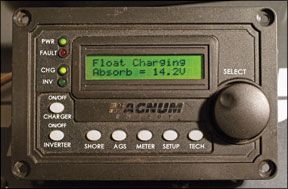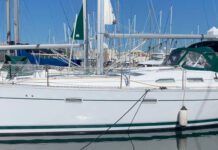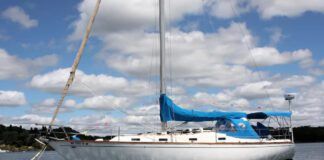Modern boats are becoming increasingly complex electrically and electronically. Customer expectations call for all manner of home-like creature comforts on board. Things like flat-screen TVs, sophisticated audio systems, onboard computers, air-conditioning, and light-dimmers are the new-boat norm, increasing the demand for AC-power systems that can deliver clean, undistorted power with a minimum amount of electronic or magnetic interference.

Photos by Ed Sherman
288
That’s where inverter-chargers come in. In the April 2005 issue, Practical Sailor compared six 2,000-watt DC-power marine inverter-chargers. Nothing has changed since then in regard to how they work. What has changed is that today, there are more players offering this equipment, and the level of sophistication in the devices’ monitoring and calibration systems has been ramped up. In light of this, Practical Sailor editors decided a fresh look at the product group was in order.
Because inverter-chargers are essentially two devices in one, we’ve opted to present our recent tests in two parts. In this issue, we take a look at the devices’ inverters and in an upcoming issue, we’ll report on the battery chargers.
How We Tested
For our tests, the inverters were powered by a West Marine flooded-cell, deep-cycle battery with a 90-amp-hour rating. For loads, we used a series of 200-watt lights that could be separately switched, a Lutron AC light dimmer control, and a Vizio HD flat-screen television to test for interference and functionality of the modified-sine wave units.
Inherent in a modern boat’s complex power system is the problem of radiated interference. Electromagnetic interference (EMI) and radio frequency interference (RFI) have become installer nightmares as we try to jam all this equipment into small spaces.
To that end, we tested each product for both EMI and RFI outputs and established a “safe zone of separation,” a minimum safe distance for mounting the inverter-chargers away from other equipment that may be either magnetically or noise sensitive.
It’s important to note here that some vendors will tout their product’s compliance with FCC Class A standards relative to radio frequency interference. This is rubbish, in our view. FCC Class A basically addresses RFI in residential installations, i.e. houses. The typical home offers much greater latitude in terms of equipment location to minimize the effects of RFI than a 35- or 45-foot boat.
To test for electromagnetic emissions, we scanned each unit under load with an A.W. Sperry EMF-200A Electromagnetic Field Radiation Tester. For our radiated noise tests, we used a Grundig G2000A AM / FM shortwave radio (frequency spectrums from 540-1700 kHz, 88-108 MHz and 2.3-26.1 MHz) and a Standard Horizon handheld VHF radio (160 MHz).
We looked at the waveform delivered from each unit and calculated the harmonic distortion on the true-sine wave units, comparing them with normally accepted tolerances. To make our distortion and waveform evaluations, we used a Fluke 867B connected to a laptop computer running Flukeview software.
For cruisers, conserving energy is important, so we also compared DC current draws to AC current draws to calculate the basic efficiency of the units. Efficiency figures will vary based on demand load and battery voltage; most inverters’ efficiency will improve with higher loads. All test products were rated for efficiency using the same loads and voltage. We also measured each product’s DC current draw with the units in “standby” mode—connected to the DC source, ready to supply AC power, but at idle.
We also compared continuous and peak outputs. This specification is quite important if you are going to be operating equipment that has a motor in use for part or all of its function. Motors draw considerably more current on startup than in normal operation, so you must have a capable power source to handle the load. Amperage readings were measured using a Blue Sea Systems 8110 True RMS meter and an Extech 380942 True RMS clamp for comparison.
We considered each product’s ability to combine multiple inverters in a parallel configuration to provide more power if needed. The ease of a DIY installation and manufacturer-supplied instructions also were evaluated. Finally, we looked at price and warranty to determine the best value.
What We Tested
Marine DC inverters, which change low-voltage DC energy (usually from a battery bank) into AC line voltage, are basically divided into two classes: True Sine Wave (TSW) and quasi or Modified Sine Wave (MSW). Each uses a different method to produce AC voltage. (For more on this, see “Inverters 101,” above.) At the time of our 2005 test, there was a considerable price difference between TSW and MSW inverters—that’s not so today.
For this report, testers evaluated modified, or “quasi,” sine wave units from Charles Industries, Magnum Energy, ProMariner, and Tripp Lite, and true-sine wave units from Magnum, Mastervolt, ProMariner, and Xantrex. All test units were in the 2,000- to 3,000-watt output range.
Newmar and Xantrex recently released new units that were not yet available when this test began; we plan to test these in a follow-up report.
Charles IQ-2600
Charles Industries’ IQ-2600 was by far the heaviest and largest inverter-charger in our test group; however, it also has the highest output. Built in the U.S. by Vanner Industries, the IQ-2600 is UL (Underwriters Laboratories) Listed and Approved. (See “Industry Standards,” above, for more on UL certification.)
The IQ-2600 performed well in all of our output testing and met its specifications with no problems. As in our 2005 tests, it was the most efficient of all the units we compared (93 percent), and it had the highest output ratings among the products in this round of testing.
The IQ-2600 uses a traditional, low-frequency transformer, which accounts for most of its heft. It does emit some pretty powerful EMI and RFI, particularly RFI at AM radio frequencies. A 36-inch separation brought the noise and magnetic emissions down to nothing, so separation from magnetically or

288
radio-frequency sensitive equipment is a must. Its standby current draw on the batteries was middle of the road at 1.2 amps.
The IQ-2600 is available with an optional remote monitor and control panel and has some sophisticated control functionality like automatic power transfer switching and auto power management, both useful features discussed in our April 2005 issue.
The Charles quasi-sine wave inverter’s waveform struggled in our light dimmer test. The dimmer simply would not function, so if your boat has light dimmers, this unit won’t work on those circuits. The waveform saw no effect during our flat-panel TV testing, however.
With a price of $3,500, the IQ-2600 was the most expensive in our test.
Bottom line: This is a ruggedly built, solid performer that has a solid track record. If weight and space aren’t issues on your boat, and higher output and reliability with a good history are of primary concern, the IQ-2600 may be a good choice.
Magnum MS2000
Fairly new to the marine market, the Magnum MS2000 inverter is ETL Listed. (See “Industry Standards,” above.)
The TSW Magnum uses conventionally wound transformers in the MS2000, but it weighed nearly half of the Charles IQ-2600. Of course, the MS2000 had considerably less output than the IQ-2600 with continuous ratings of 2,000 watts and a surge rating of 2,800, compared to the IQ-2600’s 2,600 and 7,800 watts, respectively. The Magnum’s lower output correlates to the lighter weight.
The MS2000 delivered an impressive standby current draw of only 0.6 amps. As with the Charles unit, our tests showed fairly high EMI and RFI emissions that required a 36-inch separation from other equipment, and low harmonic distortion was calculated at 3 percent.
Testers really liked the MS2000’s optional remote monitoring panel ($230), which both testers and the manufacturer highly recommend using. Testers also noted that the device was easy to set up and easy to use with user-friendly software and simple initial calibrations.
The MS2000 comes with a three-year warranty, the best in this test group.
Bottom line: This unit will effectively run any AC equipment connected to it. At $1,750 (with the optional remote panel), the MS2000 is a Practical Sailor Recommended product among TSW inverters.
Magnum ME2012
Magnum’s ME2012 is an MSW inverter, so it may not effectively power some distortion-sensitive equipment. As with the Charles IQ-2600, the dimmer control would not function during testing, but the Vizio TV performed just fine.
The ME2012 is ETL Listed for compliance with all of the relevant standards. (See “Industry Standards,” page 18.) As with the MS2000, testers recommend using it with the optional, easy-to-use remote monitor/calibration panel.
This unit measured the lowest standby current draw in the test—0.45 amps DC—a valuable trait for cruising sailors who want ready-to-go AC power with a minimum of battery charge depletion. Its calculated efficiency during tests was 91 percent, also a desirable feature for those trying to maximize battery state.
Measured EMI and RFI were moderate, requiring 36 inches of equipment separation to negate the emissions.
The ME2012 retails for $1,650, with the optional panel and a three-year warranty. With there being only a $100 difference between the ME2012 and the TSW Magnum, we’d opt for the MS2000, unless motor circuits are in the plans. The peak current for the ME2012 is 3,700 watts compared to the MS2000’s 2,800 watts.
Bottom line: A solid competitor in the MSW field, the ME2012 would be easy for a DIY installer to conquer.
Mastervolt Combi 12/2000-100
The Mastervolt Combi 12/2000-100 was the only test product made in Europe for the U.S. market. Long known for its innovative solutions, Mastervolt’s Combi clearly demonstrated some of the real advantages to the company’s approach to inverter and charger products in recent years.
This unit, unlike most of the others in our group, uses a high-frequency switch-mode technology as a basis for its voltage conversions. The result is a unit that is not dimensionally small in its form factor, but at 24 pounds, it was one of the lightest units in the test group.
Because it is made in Europe, the Mastervolt is certified by the manufacturer to be compliant with some really tough International Standards Organization (ISO) standards. Standards in Europe for such things as EMI and RFI are much stricter than they are in North America, and our measurements on the Combi bore this out. According to its maker, it’s also third-party tested to ABYC and UL standards.
Magnetically, we measured a peak of only 54 milligauss of emission compared to off-scale readings of more than 200 milligauss, dramatically lower. As for RFI emissions, our tests showed very low noise at all frequencies. Only 18 inches of separation completely nulled noise and magnetic emission readings, making this a good choice for installations near sensitive equipment.
Mastervolt boasts a peak wattage rating of 4,000 watts, one of the highest among 2,000-watt continuous inverters. Our tests confirmed this capability.
Calculated harmonic distortion of the Mastervolt Combi’s sine-wave output came in at a mere 1.5 percent, an excellent reading by any account, which ensures that this unit can power even the most sensitive AC appliances. The unit tested at 88 percent efficiency, a very good showing, especially for a TSW device.
One important installation factor for any European inverter is the set-up for North American power that requires an AC neutral-to-ground link at a source of AC power. The default setting for the Mastervolt is to not have this link made internal to the unit. It is programmable by carefully adjusting dip-switch settings in the device, as are other important functions for output calibration and such.
The Combi is engineered to be “stackable,” or paralleled with a similar inverter to double the effective output. Also, the Combi is completely network capable, which may be significant for the more sophisticated boats using NMEA 2000 integrated systems. Another unique feature of the Mastervolt is its free software program, “MasterAdjust” (downloadable at www.mastervolt.com), which allows the user to check the status of the battery charger function and the inverter and power transfer functions, and to set switching parameters to meet system specific needs, via a laptop computer.
The most sophisticated device in test group, with power sharing and power boosting, the Mastervolt Combi 12/2000 has a list price of $2,599.
Bottom line: A high-quality product with a host of unique features, the Mastervolt Combi is recommended, particularly for use with highly sensitive electronics.
ProMariner Combi 2500 QS
We had high hopes for the two Combi units we tested from New Hampshire-based ProMariner. Their form factor renders them convenient for either flat or bulkhead mounting, and their 43-pound weight was in the middle of the test pack. Also, they

288
were the only units in our test group that truly met the spirit of the American Boat and Yacht Council’s (ABYC) grounding recommendation. (See “Staying Grounded,” above.)
The ProMariner Combi 2500QS had an efficiency value of 89 percent, on par with others in the test group. Its standby current-draw was also in the same range as others at 0.55 amps.
The 2500QS had extremely noisy emissions both magnetically and in audible radio frequencies. Testers were able to clear the magnetic interference with a 36-inch separation, but it took nearly 6 feet of separation to get the noise to stop on the RFI side of things. The noise was evident throughout our entire test frequency spectrum. The 2500QS should not be mounted anywhere near an onboard radio antenna.
The owner’s manual discusses the unit’s compliance with FCC Class A requirements. As explained earlier, FCC Class A is not particularly relevant to marine installations, and the unit we tested was quite noisy. The manual went on to explain that the unit was designed to comply with ABYC standards and applicable UL standards, but there is no mention of any certification associated with this design concept.
The unit is CE marked, but our test results left testers skeptical that the unit we tested actually complies with the European Union’s strict magnetic and radio frequency emission standards.
During testing, the unit did seem to keep up with our stepped wattage and peak wattage tests, so there doesn’t seem to be any disparity there.
The Combi 2500QS has a list price of $1,300 and a two-year warranty.
Bottom line: We commend ProMariner for being the first to comply fully with the ABYC grounding recommendation. However, its average test performance, coupled with its high RFI, held it back.
ProMariner Combi 2000PS
Again, we had high hopes for the TSW ProMariner Combi 2000PS (pure sine). But, our testing showed some flaws in the unit we tested.
Emissions were nearly identical to the 2500QS unit, and the efficiency levels were 73 percent, the lowest of all the units tested. The standby current draw was an acceptable 0.75 amps.
On the plus side, the waveform demonstrated a remarkably low 1-percent harmonic distortion, so it passed all of our equipment tests with flying colors. With that level of distortion, the 2000PS could run even the most sensitive gear. The case and grounding system stud are identical to the 2500QS. The output, both continuous and peak, were within tolerance.
Priced at $1,400, the 2000PS has a built-in monitor panel that can be removed and mounted remotely, making this unit the least expensive of the TSW units we tested.
Bottom line: Because of its extreme emissions and low efficiency, the 2000PS would not be our first choice.
Xantrex Prosine 2.0
The Prosine 2.0 has been around for a few years, and both it and its maker, Xantrex Technology, have proven track records. Because Xantrex is a Canadian company, the unit is certified by the Canadian Standards Association (CSA) to comply with UL standards.
Like the Mastervolt Combi, this TSW inverter packs a high-frequency transformer in a lightweight unit. It has an excellent form factor for easy location on a horizontal or a vertical plane, and its light weight will minimize strain on boat structure.
The Prosine demonstrated the lowest magnetic and RFI emissions of all of the units tested. A mere 12 inches of separation negated all interference.
Our calculated efficiency for the Prosine 2.0 was right on target at 89 percent, and the standby current draw was a mere 0.6 amps. Harmonic distortion also put this inverter at the top of its game with only 1 percent.
Our continuous and intermittent wattage testing of this unit verified its specified 2,000 watts continuous and 4,500-watt surge ratings. The documentation that comes with the unit is good, and DIY installation is realistic, in our opinion. Testers did find the calibration instructions a bit convoluted.
Like the Mastervolt Combi, the Prosine is stackable, but in a series configuration. This enables a user to create a 120-/240-volt capable system, which could be useful for running a clothes dryer, for example.
Bottom line: Priced at $1,900, the Prosine 2.0 is an impressive unit, and we highly recommend its inverter.
Tripp Lite MRV2012
Tripp Lite, a Chicago-based maker of power protection devices, manufactures several inverter-charger units, including the MRV2012-UL we tested. There is really nothing too sophisticated about the MRV2012 when compared to some of the other products in our test group.
Performance issues were similar to other MSW inverters we tested. We achieved a calculated efficiency of only 77 percent and found a 2.25-amp current draw in standby mode. Emissions were moderate, similar to most of the other units we tested. Testers found that 36 inches of separation made the noise and magnetic field go away.
The MRV2012 has an optional remote monitor panel, which was not included with the unit we tested. We recommend spending the extra $149 for the remote panel as the LED array built in to the case is a bit difficult to read and is somewhat obscured by the case itself.
At 43 pounds, the MRV2012 falls in the middle of the pack weight-wise. Its continuous and peak wattage ratings tested out OK.
With the optional monitoring panel, the MRV 2012-UL sells for $1,144 and it comes with a 2½-year warranty.
Bottom line: As an inverter, it falls in a “middle of the road” category, but its simplicity and price earn it the PS Budget Buy pick. We’ll see how it performs as a battery charger in our next issue.
Conclusion
To decide which marine inverter-charger best meets your onboard power demands, first consider how it will be used, how and where it will be mounted, and what is required to fit with your electrical system. Not all inverter-chargers are created equal, so weighing the pros and cons of the different types will give you a clearer picture of what you need.
For this look at the inverter function of our marine inverter-charger test group, we recommend the Magnum MS2000 true-sine wave inverter. It is a lightweight, above-average performer, and has a high efficiency rating and an excellent warranty. We prefer lower magnetic and RFI emissions, but for the price and ease of use, we’d find a suitable mounting location.
Testers also liked the impressive Xantrex Prosine 2.0 and Mastervolt Combi.
If you want simple, low-cost raw power, and the assurance of a UL-Listed product, the Tripp Lite MRV2012 may be worth considering. It’s the Practical Sailor Budget Buy for this group of inverters.
The ProMariner devices, the 2500QS and 2000PS, proved average performers, but their high RFI and the 2000PS’s low efficiency kept them from making our top picks list.
Those boat owners for whom space, weight, and budget are of no concern may do well to take look at the Charles IQ-2600, if a modified-sine wave inverter fits the bill.
Bear in mind that this is only half of the picture. Stay tuned for the second part of this test, when we evaluate the charger function of these inverter-chargers.







































